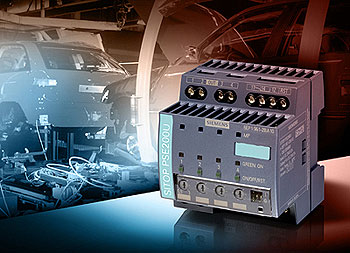 Upgrading the control system for a municipal wastewater system was going to be costly and time consuming until facilities engineers reviewed available wireless technologies. The Persigo Waste Water Treatment Plant serves the City of Grand Junction, Colo., and the surrounding communities. The facility, which cost about $28 million, was put into service on Jan. 16, 1984.
Upgrading the control system for a municipal wastewater system was going to be costly and time consuming until facilities engineers reviewed available wireless technologies. The Persigo Waste Water Treatment Plant serves the City of Grand Junction, Colo., and the surrounding communities. The facility, which cost about $28 million, was put into service on Jan. 16, 1984.After two decades of operation, the existing control infrastructure was in need of replacement and upgrade. Although, it originally had been designed to use the most reliable communications signaling technology available at the time, buried multi-conductor copper cables, age and constant use had heavily degraded the performance. As a result, maintaining the system became expensive.
Ed Tankersley, Lead Plant Mechanic, summed up the situation at the time: “Our wires underground were failing; therefore we were trying to get our plant-wide SCADA system running so everything in the plant would come back via wireless Ethernet. However, we had a relatively primitive communications system.”
Additionally, Tankersley realized, the entire system could be made more reliable, easier to maintain and more energy efficient if the controls for the dozens of pumps, blowers, valves and sensors were upgraded to take advantage of the latest Totally Integrated Automation (TIA) technology from Siemens Industry, Inc. The system Persigo now employs has two types of wireless data communications and a full complement of TIA-based controllers, HMIs and SCADA software.
To plan the system upgrade, Tankersley contacted Cody Lange at automation-technology distributor Crum Electric for help. “Ed’s vision was that he and his staff in the plant would have all the knowledge needed to not only integrate the system, but also to carry out maintenance into the future,” Lange recalls. “He wanted to have the knowledge to repair and improve the plant internally without having to call in external people or [reach out to third parties for] support.”
“My part,” Lange continues, “was primarily to help with the architecture and [provide information about] different types of I/O and processors available in the TIA portfolio. I also provided technical support as far as programming and Ed worked with Siemens’s Technical Support Hotline.”
The system Tankersley designed with Lange’s assistance relies on wireless networking throughout. For communication within the Persigo facility itself, where communications links span distances of a few hundred yards at most, they opted for a Siemens Scalance W Wireless Ethernet network. To communicate with control systems at the lift pumps miles away, they chose FHSS radio technology from wireless system developer FreeWave.
They simplified and upgraded the control architecture by adopting Siemens Totally Integrated Automation (TIA) technology. TIA is a networked control system philosophy that stresses harmonization and integration of all control-system components to reduce installation costs, with integrated diagnostics to make the installed system as easy to maintain as possible. The TIA system maximizes re-use of software components, and provides hardware components designed to work together seamlessly.
For example, Siemens S7-200 PLCs are used for small local-control systems, such as lift pumps, while Siemens S7-300 PLCs control larger, more complex equipment in the main facility. Siemens Simocode intelligent motor overloads were used on critical motor loads such as the three 300HP blowers, and Siemens WinCC SCADA (Supervisory Control and Data Acquisition) visualization software was used for plant monitoring and operation. WinCC also acts as an OPC server to Canary Labs Trend Link, logging any process variable every quarter second. This enabled Tankersley to use Siemens Simatic Manager software to program the entire plant.
Huge Service Area
Robust long-range control communications are crucial in wastewater treatment facilities because these facilities generally serve a large geographic area, and their processing facilities tend to be spread out as well. Persigo’s service area currently contains 488.8 miles of sanitary sewer lines, and this increases each year with the continued growth in the Grand Junction area. In addition, three Sanitation Districts send sewage to Persigo WWTP for treatment, including: Central Grand Valley Sanitation District (78.6 miles), Orchard Mesa Sanitation District (34.3 miles ), and Fruitvale Sanitation District (29.9 miles).
As one would expect, the wastewater flow channels to the plant resemble tributaries draining a river-system watershed. The communications-network physical topology mimics the wastewater collection system’s topology. The network is a modified star configuration (in information network parlance). Of particular interest is control communications for the network’s lift stations.
Gravity drives wastewater flow through most of Persigo’s collection system, but some parts of the system require additional pressure boosts to pass obstacles, such as hills and valleys. Hence the need for lift stations, which are automated pumps providing the additional boost on an as-needed basis.
At each lift station Persigo is using a Siemens S7-200 PLC with a Freewave FGR2 RS 485 radio for communications. Some of the closer lift stations not only provide their own data back to the plant, but also repeat data from lift stations further away.
“Our farthest jump is 20 plus miles,” Tankersley says. “The radios’ maximum range depends on how much you want to spend on antennas and, of course, line of sight. They are only one watt, but I imagine you could get 30 miles in this terrain if you selected more powerful antennas.”

Advanced Technology
“One of the primary reasons they wanted to use wireless was because this is a very old plant,” Lange recalls, “and it is uneconomical to run copper wire out to all the locations. So wireless was really the preferred solution because it saved time, money, and effort, and eliminated the need to trench and get into the vaults.”In addition, it is generally not good practice to run control and communications wiring in the same vaults as the 13,200VAC power cables. The communications signals can be disrupted by the electromagnetic fields produced by the power cables.
Tankersley says he considered a number of alternatives before deciding on this system: “At the very, very expensive end, you could run fiber, which is not practical. You could also run via satellite, which is another wireless technology, but requires monthly fees. Years ago we had a phone line to each station, but the monthly fees were killing us. You could also run cell phones at each station, but again you have a monthly fee.”
In the end, he chose to use Siemens’ Scalance Ethernet infrastructure, which is a combination of managed and unmanaged switches, and wireless and hard-wired switching. The system also includes multiple Siemens HMI panels and a WinCC Flexible runtime on a PC in the main operations building. This connects to the system’s data logging functions, and everything networks to an alarm dialing system.
One of Tankersley’s goals was to set the system up so that operators could access any process from any HMI panel in the entire plant or from the PC operator’s station in the main building. If, for example, an operator is in the digester building, he or she can look at the headworks, or the aeration basin, or vice-versa.
This is a huge advantage, particularly in the headworks building where all the sewage comes into the plant. “That’s not a place you want to spend a lot of time,” Tankersley says. To be able to look at the operations in that building from another location that is a little more pleasant was a key deciding factor. To not have to walk several hundred yards when diagnosing a plant issue, or to avoid going into an unpleasant environment to access data and control those stations, is more than convenient. It makes maintaining the plant much more efficient.
System Within a System
“Lift stations include a pump and a redundant pump,” Persigo’s Tankersley points out. Sometimes there’s a dry well for the pumps and a wet well next to it. Other times pumps are surface mounted, and then they have to vacuum pump the sewage into the pump to prime it. The bigger ones do have backup generators. Our biggest station has two 60 horsepower (HP) pumps, and the smallest stations have 2 HP pumps.”
Pump stations are automated by small, low I/O count control systems that run autonomously. Each pump station has a 24-V-powered S7-200 Siemens PLC as the controller. Each pump station also has a Freewave 900 MHz frequency-hopping spread-spectrum radio to communicate back to the main facility either directly or through repeaters (additional FHSS radios) via the Modbus communication protocol to a Siemens S7-200 at the main plant site.
The S7-200 is a data concentrator that brings everything into a second PC running Siemens’ Simatic NET OPC server. The OPC client is Win911, which is a commercial auto-dialer software that calls a phone list and relays messages to plant operators and maintenance staff for help based on alarm conditions.
Under normal circumstances each lift station runs autonomously, but they all report departures from normal operation, such as high wet-well level or power failures, back to the main facility. For example, some of the stations have backup generators. If the power fails, the generator starts up automatically. When the backup generator successfully starts, the power fail condition clears, but the original power-failure problem may still need attention. If nobody fixes it and resets the generator within a given time, the controller will call with a generator running alarm.
“At the main plant site, we are running S7-300 PLCs, which are much more powerful than the S7-200s in the lift stations,” Tankersley says. Additional equipment used in the main facility includes 8” HMI color touch panels, and 19” touch panel HMIs. All remote PLCs automating processes scattered throughout the plant have Siemens Scalance 788-1 PRO radios communicating with the main operations console via wireless Ethernet (WiFi) in the operations building.
There are two PCs in the operations building. One runs Win911 and the other is the WinCC Flexible HMI to supervise all plant processes. That second PC also data logs all plant processes, archiving the data. Because the system is stand alone, all PLCs, HMIs and PCs are synchronized to the exact time through a GPS time server.
Altogether, the system upgrade and wireless network have been successful. The new communications are much more reliable, while the new automation equipment proved simpler to install and easier to maintain than the old equipment. The staff at Persigo can now respond much more quickly to alarms at any of their locations, local or remote, and with more diagnostic information. This cuts down on their travel time for troubleshooting with most initial diagnosis able to be done remotely, eliminating wasted efforts for nuisance alarms. The new Siemens TIA based system provides an architecture that is compatible for easy future expansion, protecting the investment by Persigo and ensuring future sustainability.
Persigo Waste Water Treatment Plant at a Glance
The treatment process at the Persigo Waste Water Treatment Plant includes four steps:
1. Preliminary Treatment
2. Primary Clarifiers and Activated Sludge
3. Final Effluent
4. Sludge Processing
Design capacity for the plant is 12.5 million gallons per day of wastewater generated at homes, schools, churches, and industries, anyplace that is tied into the sewer system. The wastewater travels to the treatment facility through 462 miles of pipelines. Average flow is 8.0 million gallons/day (30,283 m3/day). It takes about 14 hours for the water to go through the entire plant. In the main facility, there are five sewage lift pumps of 100 horsepower with a capacity of 6,950 gallons/min (10 million gallons/day) each.


















